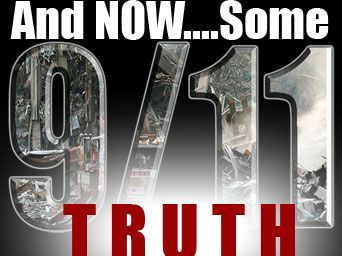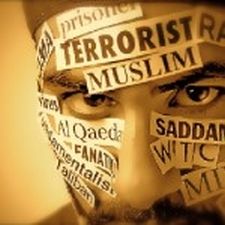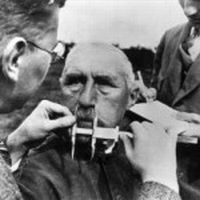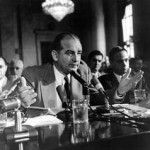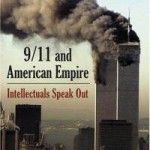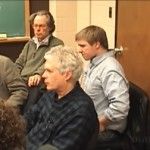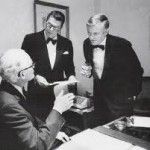Document:Waging the Battle for Reality
Contents
Document Provenance
A Review Essay on a Propagandist’s Journey in Search of his so-called ‘Conspiracist Underground’ by Anthony J. Hall Professor of Globalization Studies at the University of Lethbridge, Alberta, Cananda. Originally published by Salem-News.com, 29 May 2011
Waging The Battle for Reality
(ALBERTA) - Jonathan Kay’s book Among the Truthers was written to coincide with the tenth anniversary of the contested events of 9/11. Its contents vividly illustrate the strategic geopolitical importance of the public’s changing perception of the hit on the Pentagon and the pulverization of the three World Trade Centers on September 11, 2001.
Most of Kay’s core arguments in the text are undermined by the author’s self-confessed decision not to address directly the empirically-verifiable proof pertaining to what did or did not happen on 9/11. Kay’s zeal to avert any hard reckoning with the complex body of evidence underlying his radical conclusions helps to shed light on the culture of cover-up and propaganda necessary to keep the sacred myth of 9/11 alive in the public’s imagination.
One of the biggest lies of 9/11 involves the all-purpose boogeyman known as al Qaeda. The claim is often advanced either explicitly or implicitly that this caricatured embodiment of Islamic evil somehow extricated itself from the CIA and the other related agencies that founded the anti-communist proxy army of Islamic jihadists who, with US backing in the 1980s, overturned the Soviet-backed puppet regime in Afghanistan. Kay simply goes along with the prevalent public mythology constructed to present al Qaeda as a credible replacement for the now-defunct Soviet enemy in order to justify the further expansion, empowerment and privatization of the world’s most formidable and expensive military-industrial complex.
A very detailed interpretation of al Qaeda as the primary villain of 9/11 was fed into the echo chambers of the mainstream media from the first hours following the attacks until the present day. This interpretation has had the predictable outcome of driving a wedge between Islam and those adhering to a narrowed construction of the so-called West.
The sacred myth of 9/11 depends on planting diabolical stereotypes of Islamic terrorists in popular imagination. It injects new impulses of distrust between the worldwide ummah of Muslims and those encouraged to situate their heritage within the Judeo-Christian stream of history.
This development helps block wider appreciation in Europe and North America of the historic and continuing importance of Islam in the genesis of Western civilization, global civilization. The sacred myth of 9/11 helps renew the old imperial ploy of divide and conquer. By highlighting issues of religion and ethnicity as the primary cause of, and justification for, global conflict, the sacred myth of 9/11 diverts attention away from the huge and growing gap between rich and poor.
The sacred myth of 9/11 helps to raise walls of separation that hold back the wretched of the earth from the riches of capitalism’s blood-diamond elite. It is the vast disparities of material entitlement, not some engineered and trumped-up conflict of civilizations, that requires our most urgent attention. The perpetuation of the sacred myth of 9/11 helps divert attention from places where it is really needed such as post-Fukushima Japan.[1]
The enshrinement of 9/11 as a sacred myth was founded on the broadly-publicized religious iconography of martyred civilians slaughtered in a terrible inferno brought about through the stealth of ruthless Islamic jihadists. The Bush White House took the lead in integrating this religious interpretation of 9/11 into a twenty-first century version of American Manifest Destiny.[2] Only three days after the attacks the US President, George W. Bush, declared war at the Episcopal National Church in Washington DC.
In his sermon from the pulpit, President Bush sanctified the sacred myth of 9/11 as follows: “Our unity,” the US president intoned, “is a kinship of grief and a steadfast resolve to prevail against our enemies. And this unity against terror is spreading across the world… Our responsibility to history is already clear: to answer these attacks and rid the world of evil. War has been waged against us by stealth, and deceit and murder. This nation is peaceful but fierce when stirred to anger…. In every generation the world has produced enemies of human freedom. They have attacked America because we are freedom’s home and defender, and the commitment of out Fathers is now the calling of our time.”[3]
The sacred myth of 9/11 is based on a government conspiracy theory that Muslim terrorists, acting alone, succeeded in hijacking passenger airliners and then flying these large planes into big and important buildings. This explanation of the hit on the Pentagon and the pulverization of the three World Trade Center Towers in New York, however, has never been proven in any credible court of law. Many who should be leading the call for credible, third-party adjudication on matters of guilt or innocence in this extremely serious and complex criminal matter have averted their gaze from the lies and crimes of 9/11 with an eye to political and careerist expedience.
As long as the sacred myth of 9/11 has been allowed to prevail, there have been few legal consequences for those in government and in the media who failed in their responsibility to do due diligence in investigating the 9/11 crimes. That failure continues in the mainstream media’s ongoing unwillingness, with some few exceptions, to report in a fair and balanced way on the activities of the citizens’ investigation of 9/11, but especially on the published findings of its leading investigator, Professor David Ray Griffin.
The status quo, however, is not indefinitely sustainable. Little by little flashes of rationalism have subjected the dark superstitions permeating the public mythology of 9/11 to competing narratives. The imagery of 9/11 as the crucible of religious war is becoming increasingly difficult to sustain in light of a stream of startling revelations emerging from various parts of an unprecedented citizens’ investigation. This many-faceted citizens’ investigation is sometimes derided and sometimes celebrated as the animating force of the 9/11 Truth Movement.
This movement draws energy from the upsurge of popular disgust at the scale and scope of the lies and crimes that continue to be the métier of the national security state that was ushered into formal existence in 1947 with the passage by the US Congress of the National Security Act. Throughout most of the period since the Second World War the national security state helped to fund, organize and promote many zealous Islamic theocrats as anti-communist allies of Cold War capitalism. Like so many of their covert actions, the CIA took over this anti-Soviet strategy from Nazi agents of anti-communism.[4]
The mainstream media has been one of the key sites of the onslaught of criminal and unethical activities in which the national security state specializes. It was shown in the post-Watergate investigations of the 1970s, for instance, that all of the most important media outlets in North America hosted over 3000 paid agents of anti-communist disinformation hired by the CIA in Project Mockingbird.[5] No organization of professional journalists have ever dealt seriously with revelations that their industry is subject to deep subversion by agents of the national security state and other sponsors of propaganda paid to twist, distort, censor or obliterate truth in reporting.
Knowledge of the cloak-and-dagger history of the national security state has helped to inform the citizens’ investigation of 9/11. What really did or did not happen on 9/11? And why does it matter so much? The answer to the second question is that the continuing reign of lies required to protect the sanctity of the sacred myth of 9/11 is unusually outlandish. The unbroken onslaught of lies concerning 9/11 transcends the run-of-the-mill disinformation coming our way on a daily basis. The scale of the misrepresentations of what really happened on September 11, 2001 is simply so audacious, and the crimes enabled by the frauds so corrosive to the health and peace of the world, that extraordinary efforts of citizens’ mobilization and intervention are required. The real culprits must be identified, apprehended and brought to justice in an appropriate court where they will be afforded every opportunity to defend themselves. Only by continuing the quest for 9/11 truth is there any chance that the litany of international crimes at the core of the 9/11 Wars can be curtailed.
From Enemy Aliens to Underground Conspiracists
Enter Jonathan Kay. In his effort to prop up the increasingly discredited narrative of what happened on 9/11, namely that nineteen Saudi jihadists caught the entire military and intelligence apparatus of the United States completely by surprise, Kay resorts to many of the old tactics of media manipulation developed during the Cold War. He employs the whole arsenal of McCarthyesque clichés, where the so-called Truthers are made to stand in for stereotypical communist infiltrators seeking to subvert society from within.
By drawing on the language of eugenics and so-called “mental hygiene,” Kay depicts those that do not accept every detail of the officially-sanctioned myth of 9/11 as sources and carriers of an intellectual infection so menacing that society must be inoculated against this alleged heresy. Kay proposes as the key to his scheme of mental inoculation the introduction in the classroom of education designed to teach students to recognize and avoid the mental disease of “conspiracism.” In pushing this line, Kay goes much farther than even some of the more aggressive propagandists of Cold War anti-communism. By engaging in such rhetorical excesses to smear his opponents, Jonathan Kay raises the ante in what he refers to in an earlier draft of his lavishly-funded research project as “the battle for reality.”
Kay presents himself as a friend and proponent of the Enlightenment’s heritage of rationalism. But the author then proceeds to trash this vital legacy. By his own admission, Kay violates the rules of scholarly proof and proper citation. He fails to deal in a rigorous way with the existing evidence pertaining to what did or did not happen on 9/11 as well as what did or not happen to make this event the pretext for aggressive wars, illegal occupations, and a many-faceted assault on civil liberties.
Accordingly, Kay fails dramatically to walk his talk by honestly addressing the very important assessments brought forward by some of the most authoritative critics of the deeply flawed official account of what happened on 9/11. Instead of delving into the alleged heresies thinker by thinker, book by book, article by article, even footnote by footnote, Kay opts to medicalize the whole matter. Without even a gloss of credentials in the field, Kay appoints himself as a practitioner his own school of social psychiatry. From this platform of quackery Kay diagnoses all those who do not share his worldview as victims of “collectively experienced mental illness.”
In Kay’s virulent verbiage he throws around generalizing terms like “Truther,” “Trutherdom” and “conspiracist” in much the same way that bigots of another area could safely deploy terms like nigger, wap, pinko, kike, papist or homo to stigmatize and dehumanize whole groups deemed unfit for full integration into polite society. Kay’s resort to the toxic terminology emerging from racist taxonomy shows up in his identification of “the different breeds of conspiracy theorist.” [6] In this fashion the good, bad or indifferent intellectual work of particular activists is not dealt with on its own merits or demerits. Instead, the power of stereotypes is invoked so that masses of individuals can be set up for indiscriminate smear and ridicule.
In Kay’s demonology, the so-called Truthers become the heirs of the enemy aliens once targeted for deportation by the US Justice Department during the Red Scare after the First World War. They are set up as domestic equivalents of the so-called unlawful enemy combatants. The category of unlawful enemy combatants is based on the creation of a legal fiction advanced by the US Executive branch in order to give cover to the uninterrupted orgy of illegal torture, arbitrary incarceration and extrajudicial murder done in the name of the sacred myth of 9/11. In Kay’s hit job, “typical specimens” of his invented syndromes of “conspiracist” dementia are said to offer examples of “incurable disease.” (315)
Kay’s book is one part of a series of initiatives aimed during the tenth anniversary of September 11, 2001 at pointing audiences away from the reality that many conscientious professionals have already demonstrated at risk to themselves and their careers that the evidence does not support the sacred myth of 9/11. The extremism displayed in Kay’s defense of the superstitions attending the officially-sanctioned conspiracy theory makes Among The Truthers a very significant work, one that will be remembered much like Joseph McCarthy’s anti-communist tirades are remembered today as telling snapshots illustrating a particularly extreme instance of America’s need to affirm its superiority through the demonization of others. The well-known propensity to define US identity through acts of physical and rhetorical combat with real, imagined or manufactured enemies is epitomized by Kay’s attempt to cast himself as a modern-day whistle blower calling attention to what he deems to be an upsurge in un-American and anti-Israeli activity.
Jonathan Kay's smearing of so-called "Truthers" as "conspiracists" plays on many of the same themes and techniques employed in the early 1950s by Senator Joseph McCarthy and his Congressional Committee on Un-American Activities
The single individual that has done the most to expose the many internal contradictions and inconsistencies in the government account of 9/11 is Professor David Ray Griffin.
Of Professor Griffin’s three dozen or so well regarded academic books, the last eleven deal with both big picture analysis and detailed assessment of the minutiae of what did or did not happen on 9/11.[7] Kay refuses to address the substance of Professor Griffin’s publications, which can be viewed as mandatory entry-level reading for anyone with an interest in getting up to speed on the academic literature of 9/11.
Instead of dealing with even one significant aspect of Professor Griffin’s oeuvre, the non-academic Kay simply writes off the publications of his chief nemesis as those of the “leading crank” of the 9/11 Truth movement. (193) Kay similarly dismisses the peer-reviewed scholarship of Professor Paul Zarembka and the investigative reporting of veteran Canadian journalist Barrie Zwicker as that of “Truther cranks.”(190)
Kay’s resort to name calling as a substitute for genuine engagement with the burgeoning literature of 9/11 Studies is reflected in his shoddy and unscholarly approach to documentation. Tellingly, Among the Truthers contains no footnotes or endnotes. On page 20, however, the author does include in the body of his text a single paragraph giving the precise titles of the handful of publications and web sites, including Screw Loose Change, that support his embattled side in a debate of pivotal geopolitical significance for the future prospects of war or peace on the planet.
By failing to cite systematically the publications of the targets of his hit job, Kay deprives his readers of the capacity easily to assess for themselves whether or not the author’s criticisms and caricatures are based on credible evidence. As a substitute for evidence Kay resorts to the kind of psychobabble developed by Michael Shermer, a TV performer who frequently impersonates a professor in the mainstream media. All that really backs Shermer’s personae as an academician is an ephemeral, part-time teaching position in the same community— Claremont California– where the tenured, prolific and full professor, David Ray Griffin, has spent the majority of his much-celebrated academic career.[8]
Michael Shermer Exposed Mischaracterizing
his Academic Credentials
The demeaning outcome of Kay’s effort to substitute name calling for engagement in the scholarly literature of 9/11 is most evident in chapter five. Here Kay extends his Shermeresque topography of alleged deviance to demean his opponents as examples of “the damaged survivor,” “the cosmic voyageur,” “the clinical conspiracist,” “the evangelical doomsayer,” “the firebrand,” and the author’s most all-purpose put down, “the crank.”
Kay reserves some of his most visceral expressions of contempt for those he slights for the alleged crime of being middle aged. “Many come to the crankerdom in middle age,” the author posits. (191) In this tawdry fashion Kay would sweep aside the significance of Richard Gage’s work. Gage is the founder and leading voice of the 1500 member strong Architects and Engineers for 9/11 Truth. Kay chooses to emphasize what he characterizes as Gage’s “midlife crisis” rather than deal with the reasons why Gage has been reaching wider and wider audiences with his frequent, well-attended and well-illustrated public presentations explaining the science of how the three World Trade Center Towers plunged through the course of maximum resistance into their own footprints at speeds near that of free fall.
Kay pontificates, “the children grow up, the hair falls out, careers plateau, physical powers ebb….. Like all forms of midlife crisis, the sudden lurch into conspiracism offers middle-aged men a sense of revitalization and adventure. In some ways it offers an even more complete escape than the proverbial mistress and sports car.” (159)
Kay offers an explanation of his preference for character assassination over genuine engagement with the writings and marshaled evidence of those he characterizes as deviants and enemies of the Enlightenment’s vital legacy of rationalism. Apparently the market made him do it. Near the end of his book Kay explains, “’Debunking books don’t sell, one New York City editor explained to me when I told him my original draft of Among the Truthers contained several long chapters explaining the logical fallacies within 9/11 Truth theories. ‘Conspiracy theorists won’t believe you. And normal people don’t need to be told what you’re telling them. So you have no audience’” (320)
Kay’s advisor sees the world as a place divided between supposedly “normal people” and those with the audacity to disagree with Kay’s characterization of reality. Kay’s discussion of his missing chapters entails a recognition that he has not dealt in Among the Truthers with the evidentiary basis underlying his sweeping and generalizing allegations. Kay could easily rectify his claimed removal of the debunking chapters by publishing them on the Internet. But do these missing documents really exist, or is the author being disingenuous?
Come clean please Mr. Kay. Let’s see if you can back up what you say you have done on the way to your book’s conclusions where you posit that there is no merit in anything written by a host of reputable scholars, journalists and technical experts. Many of those you dismiss, but particularly Professor Griffin and Barrie Zwicker, have careers that are much more distinguished than your own.
Like his supposed removal of chapters said to contain his engagement with the evidence, Kay is prone to disappear whatever does not conform to the sanctified religious myth of 9/11 that the author so evangelically embraces and disseminates. Kay is either unaware or unwilling to discuss some of the most important scholarship to illuminate the substance of a defining event in recent global history. He only refers tangentially, for instance, to one of the pioneers of 9/11 Studies, Professor Michel Chossudovsky, an economist at the University of Ottawa. Kay does not deal at all with the important 9/11 work of Professor Graeme MacQueen, the Harvard-educated scholar who is the founder of the Peace Studies program at McMaster University.
Kay also disappears from his survey of the so-called truthers, to mention only a few, Paul Craig Roberts, Ray McGovern, Yukihisa Fujita, Andreas Von Buelow, Splitting The Sky, Travis Ball, Kevin Pearson, Leonid Ivashov, Guillietto Chiesa, David Chandler, Anthony Lawson, Kevin Bracken, Mark Crispin Miller, Debora Blake, Kevin Ryan, Carol Brouillet, Adnan Zuberi, Cynthia McKinney, Susan Lindauer, Kristina Borjesson, Michael Pengue, Fran Shure, Gordon Duff, Diane Castillo, Elias Davidsson, Hamid Gul, Paul McArthur, Jeremy Rothe-Kushel, Richard Brinkman, and Bill Christison. The list could go on and on of those serious and accomplished figures that do not share Kay’s complete, unquestioning and unqualified embrace of the sacred myth of 9/11.
Attacking the Messengers
While Kay makes much of the advice of his editor friend who is said to have dissuaded him from debunking the sacred myth of 9/11, he also disappears from Among the Truthers any account of the author’s important editorial revelation published in October of 2008. In a surprising op ed column Kay acknowledged that he had persecuted and smeared in print a so-called 9/11 Truther without doing any research at all to back up his attack. He admitted that he could probably get away with continuing to lie to his readers by reassuring them he had read the relevant literature on 9/11. Kay continued, “But the truth is I haven’t… I never bothered with schooling myself on the minutiae of 9/11-ology… I never felt the need to because, on a purely instinctual level, I always felt the Truthers case was complete nonsense.”[9]
Was Kay genuinely humbling himself in making this admission that he depended on instinct rather than evidence in assessing the truth of what did or did not happen on 9/11? How many other public intellectuals who follow Kay’s lead base their position on 9/11 on instinct and a sense of what is expedient for their careers rather than on their own reading of the relevant scholarly literature? Was Kay lying in declaring his intention to investigate or was he simply planting a necessary cover story calculated to gain access to those he would interview with the preconceived object of depicting his subjects as bottom feeders in the so-called conspiracist underground?
Jonathan Kay + 911 Researchers
Dallas Hansen of Winnipeg and New York has presented his own assessment of the sincerity of Jonathan Kay’s declaration in the National Post that he was setting out to discover the truth about 9/11. Hansen describes Kay’s lazy and detached presence on the edges of the eighth-anniversary events in New York City on September 11 of 2009. After giving a detailed account of all the important speeches and interview possibilities Kay missed by preferring to stay holed up in his hotel room, Hansen addresses the editorialist as follows” You were never among the truthers— rather you acted as though their ideas were a contagion from which you could stay immune only as long as you stayed in your ivory tower.” Hansen completes his short account with a comment about Kay’s preference for Wendy’s bacon cheeseburgers over the food for thought that the author could have ingested had he opened his mind and come out of his self-imposed isolation. [10]
Although Kay makes a major point in his text of drawing the connections between the those who claim to have debunked the government’s account of the killing of John F. Kennedy and those who claim to have debunked the government’s account of the events of 9/11, Kay makes no reference whatsoever to the prolific scholarship of Berkeley Professor, Peter Dale Scott. Scott has written specifically about how his investigations into the “deep politics” of the Kennedy assassination have influenced his research methodology and mode of analysis in 9/11 Studies.[11] Like Professor Griffin, Professor Scott is one of the more celebrated stars of his home university.
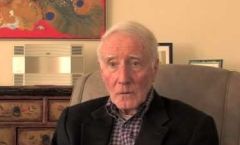
Professor Scott, who is now well into his 80s, began his career as a Canadian diplomat before he moved on to the English Department at the University of California at Berkeley. This son of Canada’s legendary civil libertarian, F.R. Scott, is far better known in the United States than in his native Canada. In ignoring Professor Scott’s scholarly contributions on 9/11 and many other topics, Kay has contributed to preventing broader recognition of the scholarly and poetic contributions of a very accomplished and erudite Canadian.
Kay mentions me twice in his text, once as “one of Canada’s most aggressive Truthers” (168) and once as the MA supervisor of Joshua Blakeney, the recipient of the Queen Elizabeth II Scholarship at the University of Lethbridge. (271) Just prior to his publishing Among the Truther Kay chose to make national news of Blakeney’s scholarship when he wrote an editorial disguised as a news story accusing my home school of bilking the tax payers of Alberta for helping to fund the graduate studies of a so-called “conspiracy theorist.” (271) Kay treats me the same as most of the other professors he attacks in neglecting to refer in any way to any of our publications on 9/11. The one of which I am most proud is Earth into Property: Colonization, Decolonization, and Capitalism. It is a big and ambitious book published in 2010 by McGill-Queen’s University Press.
While Earth into Property covers an expanse of topics far broader than 9/11, it does go into the historical precedents and outgrowths of the events of September 11, 2001. It also presents a history of the rise of the many-faceted international citizens’ movement engaged in the quest for the truth of what did or did not happen on 9/11. The fact is, my text is peer reviewed and Among the Truthers is not. The fact is, Earth into Property is published by Canada’s most prestigious university press whereas Kay’s text is published by a subsidiary of the company responsible for Fox News, Glenn Beck’s ranting and wall-to-wall coverage of the Tea Party in the United States.
I make these comparisons with an eye on the sentence following Kay’s ridiculing of those professors who appear on You Tube, which I do fairly often thanks in large measure to the technical and creative prowess of Joshua Blakeney. Just because Mr. Blakeney and I use the New Media of digital communications to disseminate some of our theories and interpretations does not prove an aversion to, in Kay’s own words, “having to go through the lengthy, frustrating process of peer review.” (192)
Earth into Property
As far as I know Jonathan Kay has never written a peer reviewed article or book. Kay has no Ph.D. and has never held an academic position in a university. His university education is in metallurgy and law, specialties that he does not draw upon in any systematic way in authoring Among the Truthers. In spite of his decision to became an editorial writer rather than a scholar, Kay deputizes himself as qualified to dismiss as the stuff of “crankerdom” significant academic texts written by professors who have flourished in their careers by going through all the requirements of peer-reviewed publication, assessments of teaching, tenure, and promotion.
This is not to say that everything written or broadcast in the quest for 9/11 truth is uniformly sound and meritorious. Even members of the professorial contingent of the so-called 9/11 truth movement are not in every instance on solid evidentiary ground in every detail of their work. Moreover, it cannot be denied that there are some wild and unsupported and even anti-Jewish, anti-Jesuit, or anti-UN theories about who did 9/11 if the 19 Saudis with box cutters did not. As long as those public officials with a responsibility to provide the public with a credible, evidence-based explanation of the anomalies of 9/11 continue to fail in doing due diligence, however, speculation about what really happened will continue to abound.
While the jury is still out on who really did 9/11, the citizens’ investigation of the crime has already proven beyond any reasonable doubt that the debacle did not happen in the way we have been told since the early hours of the post-9/11 era. The towering figure in proving that the official explanation of 9/11 is inconsistent with the available evidence, however imperfect and incomplete, is Professor David Ray Griffin. Professor Griffin is indisputably the first and foremost among those of us in the academy who have chosen to make a specialty of 9/11 Studies. Moreover, the academic analysis of, among others, Professor Steven E. Jones formerly of Brigham Young University and the University of Copenhagen’s Niels Harrit, has made it absolutely clear that World Trade Center 7, although not hit by any airplane, plunged to the ground in the flash of a few seconds late in the afternoon of 9/11 due to controlled demolition.
YouTube - Veterans Today -
YouTube - Veterans Today -
Kay seems to criticize professors Griffin and Zarembka as well as Barrie Zwicker for being “curiously detached from the profoundly disturbing implications” that flow from the disentanglement of truth from fiction on the 9/11 file. (190) Clear Kay could not see beneath the surface. There can be no detachment from the heavy weight of responsibility that arises for those on the cutting edge of research and publication in the citizens’ investigation of 9/11. There are huge implications that arise from the disparity between the sacred myth of 9/11 and what the evidence tells us. In our shared societal efforts to address this grave matter, only the truth shall set us free. As the extreme and bombastic content of Among the Truthers attests, this quest for 9/11 truth is already proving inconvenient to the interests of those entrenched in the centers of power that give Mr. Kay his place at the table of daily public discourse.
The alternative to our reckoning with the hard truths of 9/11 is endless war and our uncritical submission to a degrading and false picture of reality based not on proven fact but on lies and superstitions convenient to power. Thus a return to the vital heritage of Enlightenment rationality, which I embrace and celebrate even as Jonathan Kay claims the same, points in the direction scouted through the tireless scholarly labors of David Ray Griffin. Similarly, it points away from the dark superstitions epitomized by the politics of Dick Cheney in his efforts in the Bush White House to broaden the reach of the national security state, but especially the for-profit and increasingly privatized components of its attending military-industrial complex.
YouTube - Veterans Today -
This imperial establishment directing the national security state and the military-industrial complex has thrived at the core of America’s political economy ever since the inception in 1941 of the permanent war economy adopted by the United States after the Japanese attack on Pearl Harbor. The elaborate government and corporate machinery of Cold War anti-communism was destined for obsolescence if al-Qaeda had not been made to come along in the wake of the Soviet Union’s demise. A global enemy was needed to justify the continuation of the military Keynesianism that has diverted the riches of the United States away from needed expenditures in health, education, basic infrastructure and social security for average American citizens. On 9/11 that necessary global enemy was made to appear just in time to reenergize the corrupt cabal of war profiteers that benefit enormously from the military Keynesianism of the United States.
The contents of Kay’s book form one small part of the elaborate process of trying to prevent the consolidation of conditions that might elevate the prospects of peace over the imperatives war and all the profits to be derived from the proliferation of state lawlessness, violence, distortion and lies. Thus the quest for the truth of what really happened on 9/11 is the necessary requirement for changing course back towards the light and away from the darkness propounded by the likes of Jonathan Kay with his warnings about a “growing conspiracist underground.”
Indeed, Kay’s literary invention of the subterranean place where the so-called Truthers are said to congregate is suspiciously akin to imagery of the dark caves where, we were told in the first hours following the attacks of 9/11, Osama bin Laden and his band of jihadists supposedly planned the attacks on the prime symbols of American commercial, military and political prowess.
Jonathan Kay’s Paranoid Style of Political Journalism
In his book-length hit piece editorialist Jonathan Kay has fashioned a text that epitomizes the intensification of the paranoid style of American politics in the twenty-first century. In his literary effort to demean, demonize and smear those with whom he disagrees, Kay cites the famous essay by Richard Hofstadter to buttress his assertions.
An astute academic observer of both the intellectual and anti-intellectual history of the United States, Hofstadter’s frequently republished essay first appeared in 1964 as a response to the rise of Barry Goldwater to the leadership of the Republican Party. The ascent of Ronald Reagan’s hero and role model to leadership of the Republican Party helped usher in an era of reenergized imperial ambitions in the United States. One recent demonstration of the pivotal character of Barry Goldwater’s political career showed up in May of 2011, when the Bushite government of Prime Minister Stephen Harper finally obtained an electoral majority in the Canadian House of Commons.
The ascent of Harper to Canada’s top job is closely tied up with the history of Kay’s employer, the National Post. In the days before the controversial press baron was criminalized and incarcerated, Conrad Black hired Jonathan Kay in the process of pointing the Post towards the right-wing extremes of political discourse in the late 1990s. The National Post has been an integral part of the process of replacing with an imported style of US conservatism the indigenous style of Canadian Toryism inherited from the British Empire’s resistance to the American Revolution. Hence it is hardly surprising that Kay’s new book, one that follows his co-authorship with Michael Ross of a text presenting a flattering account of the activities of a Canadian Mossad agent,[12] should be published by a subsidiary of Rupert Murdoch’s News Corporation.
Kay’s preoccupation with defending the actions of the Israeli government is mirrored by the politics of the agency that funded his 9/11 Studies, namely the Foundation for the Defense of Democracies. The declared mission of this organization is to “fight terrorism” through public education. The directors and advisers of the Foundation include Senator Joseph Lieberman, William Kristol, Charles Krauthammer, Richard Perle, Steve Forbes, Gary Bauer and Jean Kirkpatrick.
As the politics of Kay’s funders and advisors attest, the objectives of the Foundation for the Defense of Democracies overlap with those of the Project for the New American Century. Kay contrasts his own general support for PNAC’s agenda of increased military spending with the peace movement’s view of PNAC as a telling expression of “an imperialist faux-democracy ruled by deep-state oil barons, weapons dealers, intelligence officers, and Pentagon war mongers.” (118-120) In proposing to invade Iraq during the presidency of Bill Clinton, PNAC famously predicted that public opinion would not line up behind this initiative without the intervention of some catalyzing event comparable to the Japanese attack on Pearl Harbor.
The subtitle of Kay’s paranoid text says more about the author’s own self-consuming fetishes than any actual congregation of “9/11 Truthers, Birthers, Armageddonites, Vaccine Hysterics, Hollywood Know-Nothings and Internet Addicts.” By connecting the so-called Truthers to a list of real or invented groups so easy to bash, Kay recycles the well-known technique inherited from the Cold War of doing propaganda through guilt-by-association.
Interestingly, Kay deems it unfair when detractors apply to him the same tactics of guilt-by-association that he deploys in Among the Truthers. Kay writes, “angry activists would lecture me about what other journalists had written about their profession, as if I bore some fraternal responsibility for the crimes of my mainstream media colleagues.” (238)
Rather than deal with the evidence marshaled by those who have questioned the most unsupported and unsupportable aspects of the sacred myth of 9/11, Kay replicates Shermer’s approach by invoking a blanket fatwah on all aspects of 9/11 Studies that do not conform with the defense of the status quo. In the process Kay builds up the straw man of “conspiracism” in order to tear down this entity, not through the application of rationalism but rather through a barrage of ad hominem attacks.
In Kay’s cosmos “conspiracism” embodies an even-more-diabolical drift of analysis than the negative connotations that have come to be attached to the jingoistic and much-abused term, “conspiracy theorist.” Kay fails to acknowledge that a conspiracy is merely an instance where two or more individuals plan to realize some shared goal. Moreover, Kay introduces a definition of conspiracism that could easily be applied to him because he “consistently responds to contrary facts not by modifying his theory” of the sacred myth of 9/11 but by conjuring up in his imagination an “ever-wider circles” of conspiracist interaction. (21)
Kay follows Shermer’s lead in trying to characterize any study that looks at the covert aspects of power’s workings as the equivalent of voodoo-like occultism. Both pundits seeks to discredit virtually any analysis that would suggest elites in our own society sometimes connive among themselves to steer events towards mutually agreed-upon outcomes. In this scheme of interpretation chaos theory and randomness are privileged as history’s primary modus opendi. Much energy is directed to steering resources, attention and credibility away from any enterprise that has as its investigative goal the deepening of our understanding concerning how those who prevail in a society of stupefying inequities sometimes conspire to advance shared interests.
Kay leaves no doubt whatsoever that his purpose in writing the book is to maintain the interpretive status quo on virtually every detail of the contested events of 9/11. Timed to embellish the tenth anniversary 9/11, the appearance of Kay’s book happens to coincide with the larger push by Brand Obama to restore the tottering acceptance of the sacred myth of 9/11 through the real or virtual assassination of the real or virtual Osama bin Laden. In this way the enshrined myth of crazed Islamic terrorists at the heart of America’s most vivid demonology was put yet again in the forefront of media reporting, quite possibly to help prepare public opinion for greater military intervention to preempt Pakistan’s deepening alliance with China.
YouTube - Veterans Today -Excerpt from the BBC documentary "The Power of Nightmares", 2005.
Has Jonathan Kay gone too far this time? Will his hit job backfire? Is there anything calm and reasonable about his hysterical condemnation of alleged hysterics? Has Kay laid on his anti-conspiracist conspiracism so thickly that the effect will be the opposite of the hoped-for outcome that he, his backers and his publishers owned by Rupert Murdoch’s News Corporation seem so intent on achieving?
So zealously does Kay depend on the strategy of guilt-by-association, while evading simultaneously any serious engagement with the evidentiary basis of the arguments and theories he seeks to discredit, that his text comes across as a veritable caricature of smear through disinformation. Kay links, for instance, “Scientology, UFO groups, and 9/11 Truth” as united in supposed shared “hostility towards conventional medicine.” (173) The so-called Truthers and the larger “conspiracist” culture in which Kay situates his main targets of smear are said to draw on the heritage of “Christian Identity, Aryan Pride, militant libertarianism, states’ rights, anti-Semitism, crank monetary theories, and nativist xenophobia.” (61) The “rich soil” where “the seeds of conspiracism” are said to have put down roots is supposedly fertilized by “communism, fascism, tribalism and strident nationalism, but also more faddish intellectual pathologies such as racial identity politics, anti-Americanism, and obsessive anti-Zionism.” (326)
Kay provides list after list with the aim of picturing the so-called Truthers as two-dimensional loons suitable for inclusion in his broader anthology of cartoon-like kookiness. As Kay would have it, those who find fault with the government’s account of 9/11 draw their motivations from the same sources as those engaged in fighting the phantoms of the Anti-Christ and Satan. (31) They are alleged to be in league with the militia movement, Ross Perot, as well as the “the red-state rhetoric of Sarah Palin, Glenn Beck and Lou Dobbs.” (33) They fear the covert operations of the CIA, Mossad, Freemasons, the Club of Rome, the Royal Institute of International Affairs, the UN, M16, the European Union, and the Gorbechev Foundation, to mention only a few. (58) The larger tent of the “conspiracism” envisaged in the hot flashes of Jonathan Kay’s overheated imagination is said to give cover to those who believe Elvis did not die, Hitler secretly escaped to Latin America, and Lady Di “faked her own her own death so that she and Dodi could resume a private life outside the public eye.” (48) This array of weird contentions only scratches the surface of the author’s many rants against the real, imagined or manufactured enemies of rationalism.
According to Kay, to subscribe to virtually any unorthodox view of power’s overt or covert workings is to enter into an unwritten pact of complicity with a panorama of dissident activism ranging from the man-hating feminism of Mary Daly, to the pro-Nazi, union-busting politics of Father Charles Coughlin, to the fixation of David Ickes with the “reptilian” character of certain elites, to the homophobic preoccupations of Joseph Farah, to the psychopathic anti-communism of the John Birch Society, to even the lethal hatred of Jews epitomized by Adolf Hitler.
The intensity of Kay’s attempt to smear the 9/11 Truthers through guilt-by-association is unrelenting. “Modern conspiracist movements”, we learn from the would-be prosecutor, “fixate on the Council of Foreign Relations, the Bilderberg Group, the Trilateral Commission or—in the case of the 9/11 Truth movement—some sort of Cheney-led ‘neocon’ Star Chamber.” These fixations, Kay tells us, bring into the twenty-first century the preoccupations of “old-school conspiracists [who] insist the real demons are the Illuminati, Freemasons, Jesuits, Opus Dei, Knights Templar, Philosophes, Carbonari, Prieure de Sion, Rosicrucians, or the like” (72)
Kay quotes approvingly the view of Philip Zelikow that the so-called Truthers are made up of “cult-like” groups that are similar to al-Qaeda in trying to “set themselves up as chroniclers of an alternative history.” (259) Ultimately Kay throws a very large tent over a huge and unwieldy mass of good, bad and indifferent intellectual work. Kay declares that the awkward demonology of his constructed mythology constitutes conclusive proof of the “mind-warping effects of conspiracism.” (298)
Throughout the text Kay refers in a variety of ways to AIDS. These references seem calculated to advance the case that the health of society is imperiled by what he refers to as “full-blown conspiracism,” or, alternatively, “full-blown conspiracy theories.” (268; 270) In the end Kay declares that his collection of conspiracy theories and conspiracists are but symptoms of broader malady running rampant in contemporary society. Kay diagnoses the mental ailment he claims to have discovered to be so menacing that the malady must be combate
